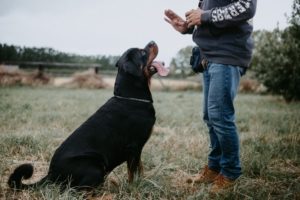Ask Crystal: Hiking Manners
Welcome to “Ask Crystal,” where you can ask your pet behavior questions! You can submit your question for Crystal at the bottom of the page!
 Dear Crystal,
Dear Crystal,
As the weather warms up, I have been thinking about taking my dog hiking at some of the local trails. Is there anything special I need to know before we go out? I want it to be a positive experience for her.
Sincerely,
Hiking Hound
Dear Hiking,
You are certainly in the right part of the country if you like to go out and enjoy the beauty of nature. There are many dog friendly parks in the area. What a wonderful way to enjoy spending time with your dog! I am so glad you are being so considerate about being prepared to take your dog out. I am sure the other hikers are appreciative as well. It is important to consider first whether your dog is appropriate for hiking. There are physical and behavior considerations that affect whether your dog would be a good hiking candidate.
 Physical: Physical considerations will vary according to the age of the dog. Puppies under 12 months and older for some larger breeds are still growing so special consideration should be taken to not over exercise a puppy. The general rule of thumb is 5 minutes of exercise per month of age two times a day. A four-month old puppy can have 20 minutes of exercise twice a day. Consult your vet for specific recommendations for your dog as the age that the growth plates fuse vary with different size dogs. The type of terrain is also important for puppies. We want to walk them on easy gentle slopes to start out. If you have an older dog, they may have arthritis or painful joints that make long hikes more damaging than helpful. Older dogs also have less strength and stamina so you will need to manage the difficulty and duration of the hike. Also, offer frequent water breaks to your dog.
Physical: Physical considerations will vary according to the age of the dog. Puppies under 12 months and older for some larger breeds are still growing so special consideration should be taken to not over exercise a puppy. The general rule of thumb is 5 minutes of exercise per month of age two times a day. A four-month old puppy can have 20 minutes of exercise twice a day. Consult your vet for specific recommendations for your dog as the age that the growth plates fuse vary with different size dogs. The type of terrain is also important for puppies. We want to walk them on easy gentle slopes to start out. If you have an older dog, they may have arthritis or painful joints that make long hikes more damaging than helpful. Older dogs also have less strength and stamina so you will need to manage the difficulty and duration of the hike. Also, offer frequent water breaks to your dog.
Even with a dog in the prime of its life, you need to build up their endurance to long distances and rough terrain. You will want to start on shorter, easier trails to build up their endurance. Just like humans have to work up to long distances so do dogs. Dogs need to build up strength so that they won’t be painful the next day or injure themselves. Start out with an easy hike that is no more than an hour with a small incline. Pay attention to how your dog acts during and after. If they seem wiped out, then you may need to choose an easier hike next time or shorten the length of the hike. Let the dog take breaks as needed and give them water to drink. Dogs also need to acclimate to the warmer weather so even if your dog is used to hiking in cooler weather you will want to shorten the hike as the weather warms up until they can tolerate it.
There are certain breeds of dogs that due to their anatomy are not built for long hikes. Brachycephalic dogs such as Bulldogs, Pugs, Boxers and Boston Terriers have shortened nasal passages amongst other less efficient aspects of their respiratory system. They are more prone to heat exhaustion and heat stroke than other breeds during physical activity. Hiking might not be the best activity for these breeds. You may be able to mitigate some of the risks by going at a slower pace, taking more frequent breaks, using a cooling vest or hiking in cooler weather.
 Behavior: In regards to behavior, is your dog frightened of people passing by or approaching it? Dogs that are fearful of strangers may not enjoy being exposed to so many new people and it may be a safety risk to the other visitors. If your dog is more nervous of strangers, you need to be your dog’s advocate and kindly let people know your dog needs some space. Is your dog reactive to other dogs? If so, until you can get your dog’s reactivity under control it isn’t a good idea to have them exposed to their triggers so frequently and closely.
Behavior: In regards to behavior, is your dog frightened of people passing by or approaching it? Dogs that are fearful of strangers may not enjoy being exposed to so many new people and it may be a safety risk to the other visitors. If your dog is more nervous of strangers, you need to be your dog’s advocate and kindly let people know your dog needs some space. Is your dog reactive to other dogs? If so, until you can get your dog’s reactivity under control it isn’t a good idea to have them exposed to their triggers so frequently and closely.
It is important that your dog has a certain amount of training so that they can behave appropriately in different situations. “Leave it” is a very useful cue for every dog to have. “Leave it” means take your nose or mouth off of whatever it is on or going towards. You can use it if your dog has some unknown item in their mouth or are going towards something you don’t want them to. That includes other dogs, people and items that you want them to leave alone. It is important that we respect other people’s and dog’s space. There are some people that are very afraid of dogs so you should not allow your dog to go up to people that have not invited it. Many dogs also feel uncomfortable with having their personal space invaded especially when they are on leash and may feel unable to flee if they feel afraid. “Watch me” is a great cue for over excited dogs to redirect their attention from things that are too exciting. Your dog should know sit or down and be able to hold a position so that if needed you can control their movement as someone passes. Every dog should have solid name recognition and recall in case they were to get away from you or if you need to call them away from something.

Equipment: Next, let’s consider what equipment you need. You are going to need a 4-6 ft. leather or cloth leash. You may consider a waist belt with a hands-free leash if you don’t want to have your hands on a leash the whole walk. Do not bring a retractable leash. Most trainers despise retractable leashes for a very long list of reasons. For our purposes, you cannot properly control your dog on a retractable leash. They are able to get way farther away from you than they should be able to and it is hard to get them back quickly enough. If your dog pulls on leash, I suggest a no pull harness like an EZ walk harness to help mitigate some of the pulling while you work on her leash walking skills at home. Be sure your dog is wearing a collar with an ID tag in case they accidentally get away from you. You will need a water bowl and water because dogs can get overheated and dehydrated just like we do. You will also need to bring poop bags with you. Not picking up dog poop is terrible for the environment. There is a lot of bacteria in dog feces that can pollute ground water not to mention the fact that it spreads disease to people and dogs alike. A doggie first aid kit is an important thing to carry in case your pup gets injured. Lastly, if you have a short haired dog, you want to bring some dog sunscreen. Yes, dogs get sunburned too!
The rules of being a considerate hiker with a dog are all about respecting other people’s space and the environment.
- Yield to other hikers: You can step off the trail and ask your dog to sit as they pass. If that is not an option, I would suggest at least walking them on the outside of you so the person can walk by without your dog interacting with them.
- Leave no trace: That means pick up that poo and don’t let your dog dig up the ground or disturb other animal’s habitats.
- Make sure your dog displays appropriate behavior to everyone on the trail. She should be able to control her impulses and respond to cues.
Remember your dog is an ambassador for all dogs. If people allow their dogs to behavior badly, then the ability for all to bring their dogs could be severely restricted. I hope you have the tools to prepare for all the adventures to come.
Until next time,
Crystal







